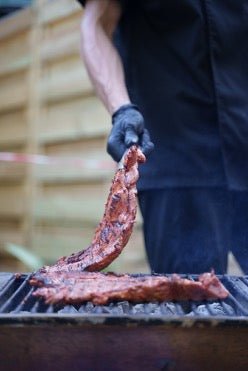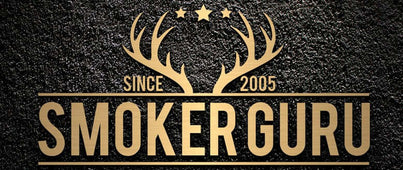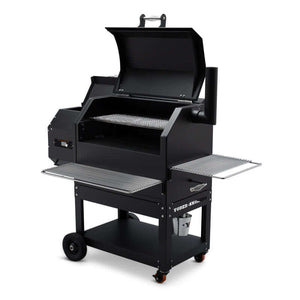On orders above $99

Can You Smoke And Grill At The Same Time?
Can You Smoke And Grill At The Same Time?
Picture a tranquil weekend afternoon; the sun is hanging lazily in the sky, the clink of ice in a glass of lemonade punctuates the serene silence, and in the background, the comforting sound of sizzling heralds an outdoor culinary adventure. The air is infused with a symphony of aromas: the rich, seductive scent of wood smoke melds seamlessly with the mouthwatering zing of seared spices. This isn't just any backyard cookout—it's an epicurean journey that marries the slow, complex flavors of smoking with the immediate gratification of grilling.

Smoking, the venerable method known for its low-and-slow approach, transforms cuts of meat into tender, fall-off-the-bone masterpieces. It’s a process that’s as much about patience as it is about flavor, where the gentle whisper of smoke over several hours imparts a depth of flavor that’s unrivaled. On the other side of the spectrum, grilling is the quintessential technique for creating a quick, crisp char, producing a tantalizing crust that's the hallmark of a perfect steak or burger. It’s the high-heat drama that seals in juices, creating a contrast between the caramelized exterior and the succulent interior.
But what if these two worlds could collide? Imagine taking the profound complexity of smoke and combining it with the satisfying sear of a grill. The result is a culinary ballet, where flavors are layered and textures interweave in a harmony that could only be described as the best of both worlds. The question beckons: can you truly smoke and grill at the same time? The answer lies in a delicate dance of heat management, timing, and a dash of creativity.
The Art of Smoking
At its core, smoking is a transformative cooking technique that imparts flavor, tenderness, and preservation to food through exposure to smoke from smoldering materials, typically wood. This ancient method has evolved from a necessity for preservation to a culinary craft celebrated for its complexity and depth of flavor. It’s a delicate interplay between fire, smoke, and time, which, when harnessed correctly, can produce dishes with unparalleled taste.
There are principally two types of smoking methods: cold and hot. Cold smoking is performed at temperatures between 68°F and 86°F and is ideal for infusing flavor into cheeses, fish, and meats that will be cooked later or eaten raw, as in some traditional charcuteries. It’s a process that can take anywhere from a few hours to a day and requires careful attention to avoid food spoiling. Hot smoking, conversely, is carried out at temperatures ranging from 100°F to 250°F and simultaneously cooks the food while it's being smoked, making it safe to eat right out of the smoker. This method is synonymous with barbecued meats like brisket, ribs, and pulled pork.

The choice of wood is critical in smoking, as each type imparts a unique flavor. Hardwoods are favored for their density and slow-burning properties. Woods such as hickory or oak offer a robust flavor, ideal for red meats. Fruitwoods like apple and cherry give a sweeter, milder touch that complements poultry and pork. Mesquite, with its intense and earthy notes, is a bold choice that should be used sparingly. Experimentation with different woods, and even the incorporation of herbs and spices into the smoking process, can lead to a range of nuanced flavors.
Moreover, the interaction between the smoke and the natural composition of the food creates a singular taste profile that can’t be replicated by any other cooking method. The compounds in the smoke penetrate the food, reacting with fats and other flavor molecules, which results in the characteristic smoky flavor. The smoke also creates a barrier, which can help in preserving the food by slowing down the growth of bacteria.
The Thrill of Grilling
Grilling is the high-octane counterpart to smoking, a cooking method defined by its use of direct, high heat to quickly cook and sear food, imparting a distinctive charred flavor and texture that has become synonymous with outdoor cooking adventures. The allure of grilling lies not just in the flavors it produces, but also in the experiential aspect of cooking over an open flame—it's interactive, immediate, and deeply satisfying.
The grilling process hinges on two primary techniques: direct and indirect grilling. Direct grilling involves cooking food directly over the heat source, perfect for quick-cooking items like steaks, burgers, and vegetables, which benefit from the intense, direct heat that sears the surface, locking in juices and creating a flavorful crust. Indirect grilling, on the other hand, places the food away from the heat source. This method is better suited for larger or tougher cuts of meat that need to cook slowly to become tender, much like an outdoor oven.

Temperature control is the cornerstone of successful grilling. Unlike smoking, which often uses consistently low temperatures, grilling requires a keen sense of when to harness the flame's ferocity and when to tame it. The chef must adjust the heat for different foods and manage flare-ups that can char the food too heavily. This control is achieved through the regulation of fuel, whether it’s adjusting the gas on a modern grill or managing the coals in a charcoal setup. Knowing when to flip the food, how to position it relative to the heat, and when to remove it from the grill are skills developed through experience and are critical to the outcome of the dish.
Grilling is therefore not just a means to an end, but a spirited activity that offers immediate gratification and a touch of showmanship. It requires a balance of intuition and technique, a challenge that when met, rewards the grill master with dishes that boast an unmistakable smoky crust and juicy interior that simply can’t be achieved through any other cooking method.
Smokers That Can Grill
For those who cherish the deep, complex flavors of smoked food as well as the seared perfection of grilled items, there are specialized smokers on the market equipped with grilling capabilities. These dual-purpose units provide versatility, allowing the outdoor chef to switch between cooking methods with ease. Some models feature adjustable fireboxes or grates that can be raised or lowered to bring food closer to the coals for grilling, or to maintain a lower, smoldering heat for smoking.
When scouting for a smoker-grill combo, look for key features that will enhance both smoking and grilling experiences. Good ventilation is crucial for controlling temperature, while sturdy construction helps retain heat. Thick metal grates are desirable for nice grill marks and heat distribution. A built-in thermometer is also essential for monitoring the cooking temperature without the need to lift the lid frequently, which can disrupt the cooking process. Additionally, ample cooking space is valuable to accommodate both direct and indirect heat setups, and an easily accessible ash removal system simplifies cleanup.
Grill Modifications for Smoking
If a dedicated smoker isn't in your arsenal, you can modify a standard grill to imbue your foods with that coveted smoky flavor. For charcoal grills, this can be as simple as employing the two-zone method: arranging coals on one side of the grill and placing the food on the other, allowing for indirect cooking. Adding wood chips directly on the coals can introduce smoke, and using a water pan can help regulate temperature and add moisture.

Gas grill enthusiasts can also join the smoking bandwagon. Special smoker boxes are available that can be filled with wood chips and placed over one of the burners to create smoke. Alternatively, creating a makeshift smoker pouch by wrapping wood chips in foil and poking holes in the top can serve the same purpose. Always ensure the lid stays closed as much as possible to maintain the smoky environment. These simple hacks allow the conventional grill to double as a smoker, offering a pathway to explore the flavors smoking has to offer without the need for additional equipment.
Smoke and Grill Timing and Temperature Management
Mastering the art of simultaneous smoking and grilling demands a nuanced understanding of timing and temperature. Because smoking is a low and slow process, while grilling is quick and hot, reconciling these two can be challenging. One strategy is to begin with smoking, as it allows flavors to develop over time. After the initial smoking phase, you can increase the temperature to transition into grilling for that perfect sear.
Maintaining the right temperature is pivotal. When planning to both smoke and grill, it's wise to start with the smoking portion at a lower temperature range (225°F to 250°F). This is where a dual thermometer setup can be invaluable—one to monitor the grill's ambient temperature and one to check the food's internal temperature. Once the internal temperature nears the desired level, the heat can be ramped up to achieve the high temperatures (around 400°F to 450°F) needed for grilling. This spike should be carefully timed; too early, and you risk overcooking during the smoking phase, too late, and you lose the opportunity for a well-seared crust.
Fuel management is also key. For charcoal grills, having extra coals ready to add is necessary for elevating the temperature quickly. For gas grills, it involves adjusting the burners to create a direct heat zone. Transitioning from smoking to grilling often involves opening vents or adjusting the fuel source to increase oxygen flow and boost temperatures.
Space Allocation
The division of space is crucial when both smoking and grilling on the same apparatus. Creating distinct zones on the grill allows for control over the cooking environment, facilitating both methods simultaneously. The grill should be organized into at least two zones: one for indirect heat, where the food is placed away from the heat source for smoking, and one for direct heat, where the food is cooked right over the flames for grilling.
To set up these zones in a charcoal grill, coals are typically piled on one side, creating a hot zone for grilling. The other side, devoid of coals, becomes the cooler zone for smoking. For gas grills, the burners are adjusted so that one side has low to no heat for smoking, while the other side is set to a higher temperature for grilling. Some advanced grillers use a three-zone setup: a hot direct heat zone, a moderate indirect heat zone, and a cool zone that acts as a safe space for food to rest or cook very slowly.
The beauty of zoned grilling lies in its flexibility. For example, chicken can be smoked over the indirect heat zone until it's nearly done, then moved over to the direct heat zone for a final grill to crisp the skin. Meanwhile, vegetables can be grilled over the direct heat. By managing the zones effectively, different foods requiring varying temperatures and cooking times can be prepared in concert, resulting in a feast that showcases the best attributes of both smoking and grilling.
Selecting the Right Wood and Spices
Achieving the perfect fusion of flavors when both smoking and grilling begins with the selection of the right wood and spices. The type of wood used can greatly influence the taste of the final product. For instance, hickory and mesquite woods provide a strong, smoky flavor that stands up well to the robustness of red meats like beef or lamb. On the other hand, fruitwoods such as apple and cherry are milder and sweeter, making them ideal for poultry and pork.

When it comes to spices and marinades, those that can withstand the extended cooking times of smoking without losing their character are best. Consider robust herbs and spices like paprika, cumin, and garlic powder, which can endure the smoke and still provide a punch of flavor when grilled. Marinades with a base of vinegar or citrus can help in tenderizing meats and can contribute to the crust formation during the grilling phase, adding an extra dimension of taste.
The Chemistry of Flavor Development
The chemistry of flavor development in both smoking and grilling is a fascinating interplay of heat and science. Smoking introduces a variety of chemical compounds to foods, including phenols and carbonyls, which contribute to the smoky flavor and also act as preservatives. Grilling, particularly over high heat, initiates the Maillard reaction – a complex chemical process that occurs when proteins and sugars in the food are transformed by heat, producing a range of flavors and brown colors. This reaction is responsible for the flavorful crust that is the signature of a well-grilled piece of meat.
Together, the slow infusion of smoke and the quick sear of the grill create layers of flavor. The smoke imparts a deep, woodsy base note, while grilling adds the complex, caramelized top notes. This combination turns a simple piece of meat into a rich, flavor-packed delicacy that tantalizes the palate with every bite.
Try the American Barbecue Systems Pit Boss at Smoker Guru

Mastering the concurrent techniques of smoking and grilling can elevate the backyard cooking experience, offering a symphony of flavors that are deeply embedded through smoking and perfectly sealed with a high-heat grill. It's a culinary dance of patience and precision, balancing the slow infusion of smoky richness with the rapid char and sizzle of the grill. A prime example of equipment facilitating this fusion is the American Barbecue Systems Pit Boss from Smoker Guru, which adeptly bridges the gap between smokers and grills for enthusiasts looking to indulge in both arts.
Embracing the blend of smoking and grilling is not only about the delectable results but also about the creativity and joy in the process. It’s a method that encourages experimentation and pushes the boundaries of traditional barbecue, allowing pitmasters and home cooks alike to explore new dimensions of flavor and texture. As you engage with both techniques, you'll discover a rewarding cooking journey that’s as much about the experience as it is about the exceptional dishes you’ll create.

